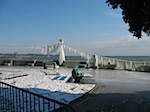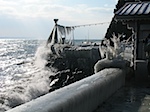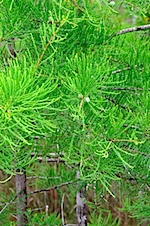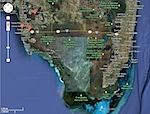It did produce some spectacular scenes, with the spray from the surf on Lac Léman breaking and freezing on everything in reach along the quais; a car in Versoix ended up coated with 2″ – 3″ of ice. 
 We returned to Florida February 21, spent a few days with Ellen, then got back into the swing of our homeless, live-out-of-your-car existence (though in case you’re wondering, we haven’t spent a night IN the car yet…..).
We returned to Florida February 21, spent a few days with Ellen, then got back into the swing of our homeless, live-out-of-your-car existence (though in case you’re wondering, we haven’t spent a night IN the car yet…..).
…We’d rented a house for ten days, and discovered it was owned by a young guy who hadn’t the SLIGHTEST idea of how to make a place warm, welcoming or comfortable: it was living in one of those “Model Units” you see advertised outside dreadful housing developments: show-room furniture, inadequate selection of kitchen equipment, and less welcoming than many motel rooms we’ve been in. … Also, it’s spring, and the cypress are beginning to come back into leaf, which is a glorious sight; they are covered with that new pale, luminescent green foliage that trees get, and in the midst of the swamps and marshes, they really stand out. We saw: Great Crested Flycatchers, many alligators (small and large), Green Herons, Tri-Color Herons, Roseate Spoonbills, Wood Storks.
We saw: Great Crested Flycatchers, many alligators (small and large), Green Herons, Tri-Color Herons, Roseate Spoonbills, Wood Storks. Together with the Everglades National Park and a series of other areas under varying degrees of protection, the Preserve forms a critical part of the south Florida ecosystem.
Together with the Everglades National Park and a series of other areas under varying degrees of protection, the Preserve forms a critical part of the south Florida ecosystem.
…This satellite view from Google Maps shows fairly clearly what an island of preservation this are is, with the Corkscrew Regional Watershed zone just to its north (the Audubon Preserve is immediately south of that in the image, though it isn’t labelled on the map). This image helps place it in context with all the other protected areas of South Florida (it is flag “A” in the image):
This image helps place it in context with all the other protected areas of South Florida (it is flag “A” in the image): So, that’s it for Florida, for this year folks.
So, that’s it for Florida, for this year folks.
Also tagged Audubon Corkscrew Sanctuary, Big Cypress Swamp, Casey Key, Fakahatchee Strand, Intracoastal Waterway, Isles of Capri, Ocala, Ringling Museum, Sarah Brooks, Sarasota





